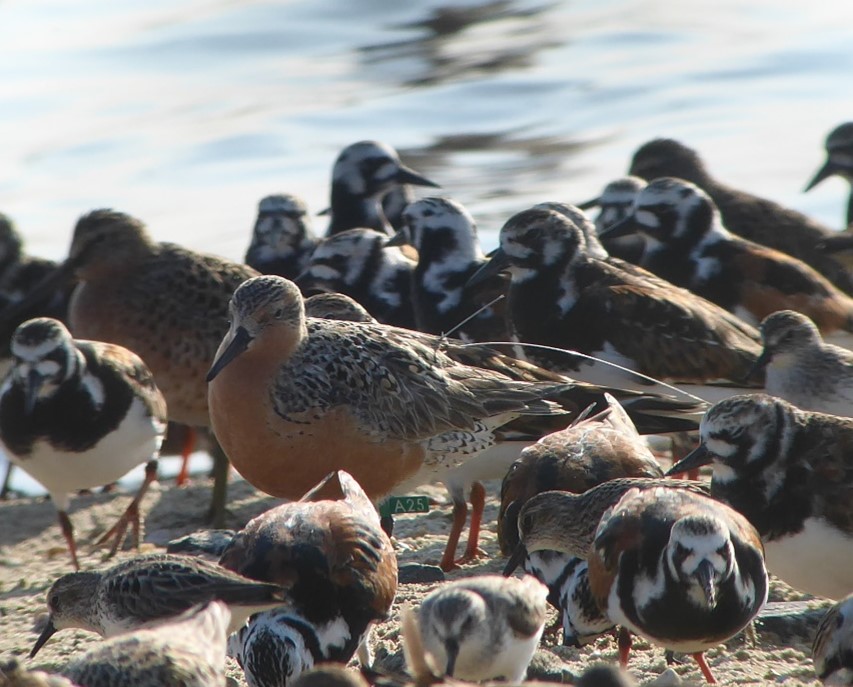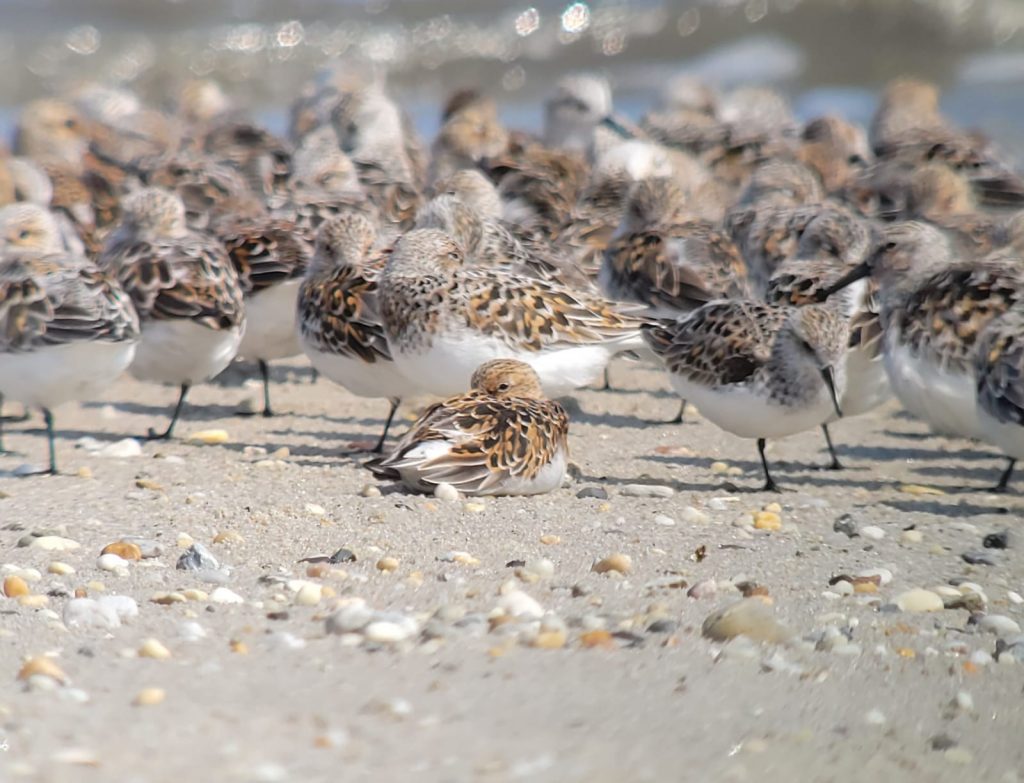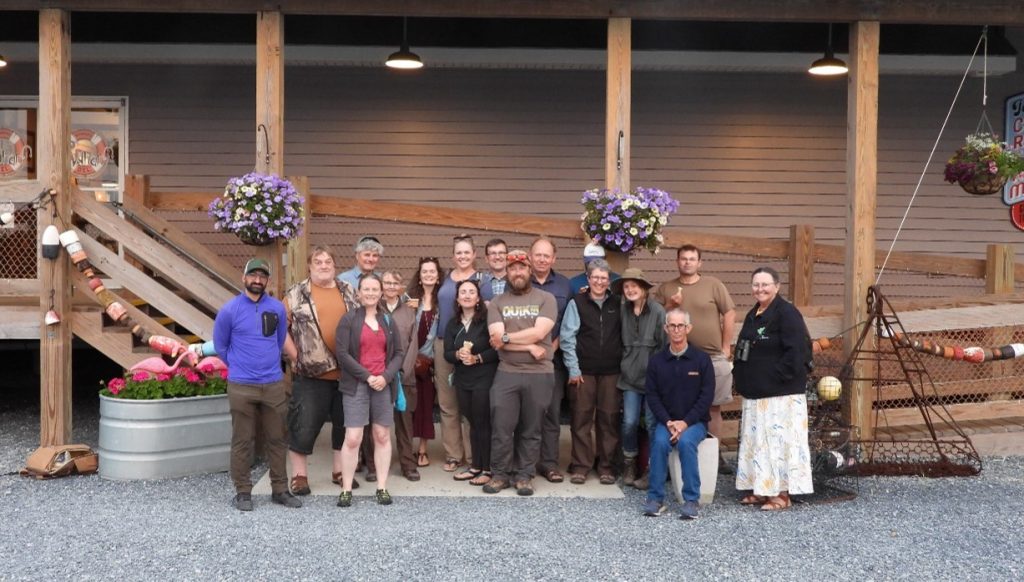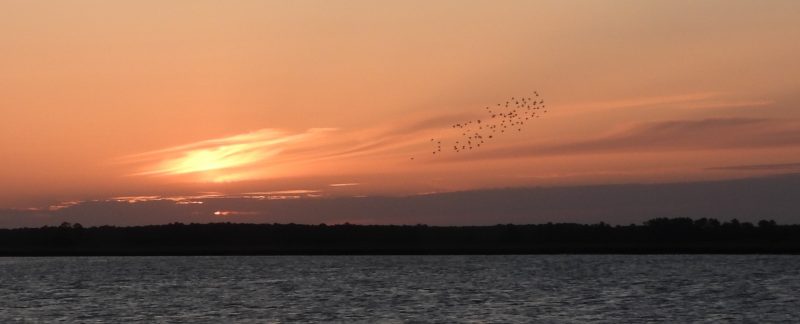Thursday 18 May
Week two of shorebird fieldwork for the WWRG team in Delaware Bay began with the team’s third cannon-net catch… At a very relaxed 09:10, a setting team set off in the Jon boat into Mispillion Harbour and made for Back Beach. Meanwhile another group readied the Skiff with the rest of the equipment by making the most impressive chain to shift everything from the pickup truck into the boat. It was a shame this wasn’t caught on video! This swift method is now used at every opportunity, with great enthusiasm and to great effect.
Catching was slightly delayed, due partly to the tide making more than expected, however this gave time to admire a handsome Skimmer sitting among the gulls on Back East. The net was fired, and we made a decent catch of 69 Dunlin, 30 Red Knot (including one bird flagged in Brazil), 25 Ruddy Turnstones, eight Sanderling, 21 Short-billed Dowitchers and 66 Semipalmated Sandpipers. Five glue-mounted GPS tags were secured to Knot, all of which had reached a good weight, and we are delighted to have already received several location points from these birds as they move on their way.

In the afternoon a group went out to survey the Mispillion beaches and had a very successful resighting session, especially on Back North and Back East. Two of the tagged birds were seen and photographed on Point North! Both were very comfortable and behaving normally. Great news and a real boost for the team to see this positive result from their hard work. To end the day, a beautiful strawberry sun sank below the horizon.
Friday 19 May
There was an early Mispillion survey in the morning and again Back North was very productive for resightings. Today Kirsty and Mark joined the Project’s director, Sam Robinson, and Shawn Sullivan, the Project’s Assistant Wildlife Biologist to survey waders (in America this term refers to herons, egrets etc.) at the Indian River Estuary, Rehoboth. Particular highlights were Common Terns, which had not nested there in many years, Glossy Ibis breeding for the first time, and good numbers of Snowy Egrets.
Another two Mispillion boat trips were completed along with other beach surveys during the day. Despite the forecast for heavy rain tomorrow, an early boat into Mispillion was planned to check out catching options again.
Saturday 20 May
And so, at a bleary-eyed 05:45, Richard, Kirsty, Guy, Jim and Flo, bedecked in what they thought was fully waterproof attire, boated out into the Harbour. After assessing catching potential, they braved the rain and sat on Back North to resight. It rained and it poured, and the team were soaked to the bone. Despite this however, they remained cheerful, managed to read a good number of flags and overall, quite enjoyed the experience, sodden though they were.
Back at base, lots of data from recent catches were checked and bands were opened in preparation for the next catch, with the help of Kat Christie, who will next year be taking up the role as Coastal Avian Biologist for the Project and has come this year to join in with surveying and catching for a few days. Unlike in the UK, some bands (rings) are bought closed and so must be manually opened before use.
Eventually the rain ceased its onslaught, another team surveyed Mispillion and a decision was made to attempt a catch for Red Knot on Back North.
In the late afternoon the whole household went to enjoy the yearly tradition of a barbecue in Dave Carter’s garden. The rain held off and in fact it became quite sunny. It was a wonderful evening of socialising, strolling around his incredible property (once crop fields, now, through Dave and Marg’s hard work over the years, a wildlife-filled landscape of woods, meadows and ponds), munching delicious food and singing around the campfire – Flo played the guitar, and earlier in the evening Dave let her drive his tractor! An evening to remember.
Sunday 21 May
Throughout the morning, several beach surveys were undertaken, a highlight being a flock of some 2,000 Sanderling at Brockenbridge, and at the house more catch data were checked for errors.

After lunch the Jon boat chugged out to Back North with the setting team of five. A nucleus of Knot and Turnstone were higher than the markers originally put down for the net position. This may have been due to pressure from a group of gulls feeding lower down. As a result, we set the net higher up than first planned. Over the next few hours, well after basecamp had settled on the beach, a repeating and frustrating pattern unfurled. Every time target species began to build in the catching area, a Red-winged Blackbird would bounce down out of nowhere, alarming, and the whole flock would lift. Though remaining admirably cool and collected, Richard stated that a certain nursery rhyme had come to mind.
The gulls moved off and did not return to the same spot and so the shorebirds gathered lower down the beach, right where the markers had originally been placed! And so, after much thinking and patience, Richard made the call to reset the net. In less than 10 minutes we had a catchable sample. It can’t have been more than mere seconds after basecamp was informed over radio that “you will not get a warning for this catch” that the net was fired. The catch was completely dry, so no lift was required, but we covered due to the large number of birds. The catch total was 401, including Ruddy Turnstone, Sanderling, Red Knot, Short-billed Dowitcher and Semipalmated Sandpiper. We finished flagging, sampling Knot feathers, and processing in an astounding 2 hours and 10 minutes, leaving the beach before dark. By looking at the ratio of carbon and nitrogen isotopes in the Knot feathers, we can amazingly figure out where the feathers were grown and therefore where the birds wintered! As the first load of people left in the Skiff they spotted a Ring-billed Gull with its leg trapped in a wooden post near the Nature Centre. A rescue mission was successful!
Back at the house we cheerfully enjoyed cottage pie cooked earlier on by Graham, and celebrated Katharine’s birthday. Everyone was very happy, and we had good fun trying to guess the number of birds caught, guesses ranging from low 300s to mid-400s. A group went out in the dark to Slaughter Beach as Richard had said there would be a big crab spawning – to much amusement, we saw a total of 2!
Monday 22 May
The big event of the day (apart from the losing and subsequent relief of then finding the Knot feathers!) was completing the first of the team’s aerial surveys. Everyone dispersed in ones and twos to the different beaches across this side of the Bay to count the Red Knot and Ruddy Turnstone as the plane flew low over each beach in turn, counting from the sky. On Slaughter Beach, Cathy and Flo saw three White Ibises flying high overhead by mere chance of looking up when they mistakenly thought the plane was coming. The most significant result from the aerial survey was that there were a lot more Red Knot on the New Jersey side!
Tuesday 23 May
At a Wash-like hour, Greg and Judy left the house to mist-net with Shawn in Cedar Swamp, and at 06:00 a team went to survey Mispillion and found more birds than they could sensibly count carpeting Back East and Back North. After assessments of the other beaches, a plan began to form for a catch on Back East.
Flag making and ring sorting were some of the day’s activities back at the house, and in the afternoon Ryan and Flo joined Shawn and two other Delaware Fish and Wildlife ecologists to survey and catch some Piping Plovers in the dunes at Cape Henlopen. A nest was protected from predators with an enclosure and three chicks were colour banded. Delaware Fish and Wildlife are doing an amazing job of protecting this species which has expanded its range in the state in recent years. There are around 2,000 breeding pairs on the Atlantic coast.
In the evening the whole team went to JP’s on the Wharf to have a well-deserved meal out. Hen Bellman came! It was fantastic to see her, and we had a great time catching up with her. We are looking forward to seeing her in a few days’ time, hopefully for a cannon-net catch. Once we returned to Slaughter Beach, the night descended into some very competitive and brilliantly silly games of table football. It was unanimously decided that Richard, Mark, Rob Rob and Guy certainly had misspent youths.

Wednesday 24 May
Kirsten left in the morning, and this was very sad for us all. We will miss her dearly and very much look forward to seeing her next season. She is such a dedicated member of the team and makes us all laugh.
Another sunny morning and the team headed off once again into Mispillion to attempt another catch. Last night the chosen catching site changed from Back East to Back North as a result of further observations of the beaches in the second two Mispillion surveys in the afternoon. Unfortunately, though we waited from 10:00 until 15:00, the catching area only ever seemed to fill with Semipalmated Sandpipers and not enough target species to form a sample. It was thought that perhaps, after all, the Horseshoe Crab eggs were in higher concentration on Back East for this was where the Knot and Turnstone were congregating!
Basecamp had fun all the same, watching a Snowy Egret fishing in a creek mere feet away, playing I-spy, and making a sand dragon! Whilst most of the team left the harbour to survey other beaches, shop and cook, a small group remained on Back North and Back East to resight.
In the public launch carpark, we found two broods of four Killdeer chicks! Such a joyful sight to see the chicks snuggling under the parents and running around in the gravel and tufts of vegetation.
As a result of not managing to catch today, another catch was planned in the evening, this time for a second go at Osprey, where we had previously been very successful with Turnstone.
And so, another week has passed for the WWRG team in Delaware Bay. On several evenings we have been blessed to watch the evening departure of migrating shorebirds in Mispillion Harbour, reminding us how privileged we are to be here.
All banding, marking, and sampling is conducted under a federally authorised Bird Banding Permit issued by the U.S. Geological Survey.
Thanks to Florence Turner for writing this blog.

